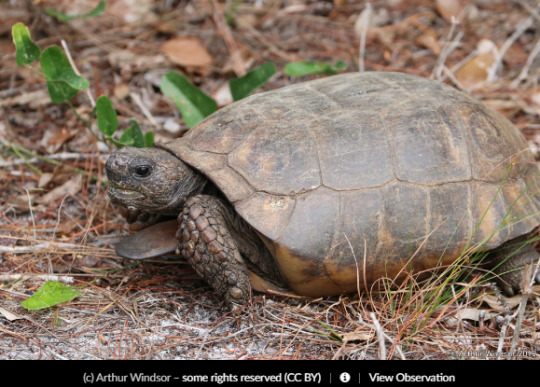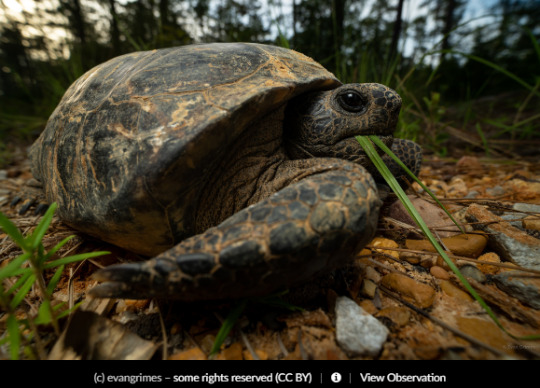#gopher tortoises
Explore tagged Tumblr posts
Text



Going to Ground with the Gopher Tortoise
The gopher tortoise, sometimes specified as the Florida gopher tortoise (Gopherus polyphemus), is a species of tortoise found only in the southeastern United States. They require highly specialized habitats of dry, sandy soils, few trees, and a variety of low-growing vegetation. These habitats include coastal scrub, pine flat-woods, and sparse prairie.
As their name implies, gopher tortoises spend a large part of their time underground. They are widely known for digging large burrows, on average 4.5 m (14 ft) in length and 2 m (6.5 ft) deep. These burrows are particularly used at night and during the winter, where they can maintain a steady temperature throughout the year. Individuals maintain a relatively small home range around their burrow(s), up to 1.6 acres. Within this range, they forage on a wide variety of grasses, flowers, and shrubs. Gopher tortoises are also predated on by a variety of animals; eggs and juveniles are vulnerable to raccoons, coyotes, bobcats, skunks, birds of prey, and snakes. Adults are more shielded, but can still be coyotes, bobcats, Florida black bears, and Florida cougars.
Like other tortoises, G. polyphemus is heavily armored by a thick shell encasing the body. When threatened, individuals can pull their heads and limbs inside the shell for protection. Adults can reach a maximum length of 38.7 cm (15.24 in) and an average mass of 5.5 kg (193.83 oz), with females usually being slightly larger than males. The coloration is rather dull to blend into their surroundings, usually dark brown, tan, or grey on top and lighter tan on the bottom of the shell.
Mating for Florida gopher tortoises can occur from March through December. When they are ready to mate, males court females by bobbing their heads and walking in circles around the female. If she reciprocates, she may allow the male to mount; this process can be repeated several times over the course of several hours. Both sexes will mate with multiple partners throughout the season. After mating, the female digs a large hole and lays a clutch of 5-8 eggs. These eggs take 80 to 100 days to hatch, and young are immediately independent. Young are extremely vulnerable to predation, but those that survive reach full maturity between ages 9 to 21. Individuals can live up to 70 years in the wild.
Conservation Status: Florida gopher tortoises are considered Vulnerable by the IUCN. The species is threatened primarily by habitat destruction and fragmentation.
Photos
Florian Marchner
Amanda Hurst
Charles Warren
#florida gopher tortoise#Testudines#Testudinidae#gopher tortoises#tortoises#turtles#reptiles#deserts#desert reptiles#scrubland#scrubland reptiles#evergreen forest#evergreen forest reptiles#north america#southern north america#animal facts#biology#zoology#ecology
139 notes
·
View notes
Text
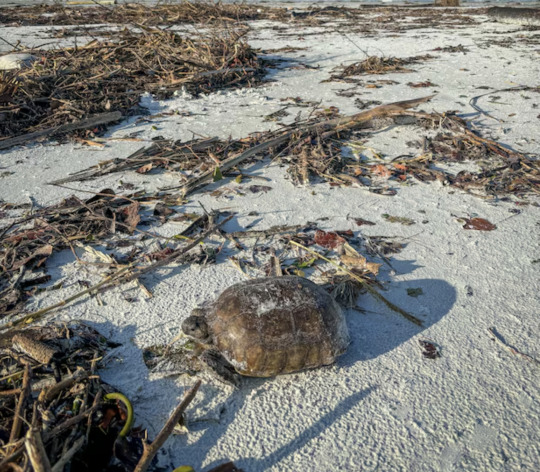
Excerpt from this EcoWatch story:
Dozens of gopher tortoises survived a harrowing sea crossing after last year’s deadly and destructive Hurricane Helene swept them two miles from their native home.
The tortoises found themselves swimming — and possibly floating — for their lives from Egmont Key national wildlife refuge to Fort De Soto County Park on a remote part of the Florida coast.
“We found them right there on the beach, so we think that a combination of some potential to float or swim, we did have massive amounts of debris that came over from Egmont Key, it’s entirely possible that they rode those debris rafts over,” Fort De Soto’s Chief Park Ranger Dave Harshbarger, who first spotted the castaways, told Bay News 9.
Before Helene, Fort De Soto had about eight gopher tortoise burrows, but after the hurricane officials said the number had grown to more than 80 spread throughout the park.
Park rangers are excited that the new residents seem to be settling in well, as they provide a host of benefits for the ecosystem.
“They’re a keystone species, which means they share their burrows with other species, and there’s been something like 250 different species recorded as living in gopher tortoise burrows,” said Anna Yu, a Fort De Soto park ranger who is responsible for the wellbeing of the gentle reptiles, as The Guardian reported.
Eckerd College is studying and monitoring the movements of Fort De Soto’s gopher tortoise population with the aid of cameras set up outside their burrows, reported Bay News 9.
2 notes
·
View notes
Text

Gopher Tortoise (Gopherus polyphemus)
Taken at Turkey Creek Sanctuary in Palm Bay, FL
#gopher tortoise#gopher tortoises#tortoise#tortoises#animal#animals#animal photography#wildlife#wildlife photography#nature#nature photography#photography#florida#florida photographer#florida photograhy#turkey creek sanctuary#turkey creek#wildlife sanctuary#nature trail#nature trails#nikon camera#nikon photography#nikon d3500#Gopherus polyphemus
16 notes
·
View notes
Text

18 burrows> 18 holes
#I make a version of this meme every year for this day no end in sight#gopher tortoise day#gopher tortoise#April 10th#memes
2K notes
·
View notes
Text


Teeny tiny baby gopher tortoise
#photography#original photographers#nature#photographers on tumblr#florida#cottagecore#reptiles#gopher tortoise#tortoise#tiny#baby animals#cute animals
1K notes
·
View notes
Text
04.16.2025 -- Story by Richard Luscombe
Dozens of gopher tortoises (Gopherus polyphemus) survived a perilous sea crossing after being swept from their homes during Hurricane Helene last summer and are enjoying a new lease on life on a remote stretch of Florida coastline.
Rangers at Fort De Soto county park near St. Petersburg say that before the September storm only eight members of the vulnerable species were known to be living there.
Now, after the astonishing journey, a count last month confirmed 84 active burrows, suggesting the tortoises quickly adapted to their new habitat after their forced eviction from Florida’s Egmont Key National Wildlife Refuge, a tiny island more than three kilometers (two miles) southwest that was pummeled by the Category 4 hurricane.
As well as sparking a surge of interest in the park in the form of visitors keen to catch a glimpse of the unexpected new arrivals, the tortoises are providing benefits for some of the animals that already lived in the 445-hectare (1,100-acre) environment.
“They’re a keystone species, which means they share their burrows with other species, and there’s been something like 250 different species recorded as living in gopher tortoise burrows,” says Anna Yu, a Fort De Soto ranger who has assumed responsibility for the roving reptiles’ well-being.
“Everybody in the ecosystem benefits from gopher tortoises being there, and we’ll hopefully see an increase in biodiversity in the park. Because we have all these new burrows, other animals are able to use them, like eastern diamondback snakes, black racers, all kinds of different reptiles,” she says.
“The last time a gopher frog was listed as being one of the species in the park was in 2016, so it’s really cool to think that maybe some of these really imperiled species that rely on gopher tortoise burrows to survive might make their way back.
“I don’t expect to see frogs popping up everywhere, but there’s certainly more of a chance than before this happened.”
Yu and her colleagues knew the tortoises had come across the water from Egmont Key because biologists from St. Petersburg’s Eckerd College, who were studying them, had drilled small holes in their shells as identification markings.
Tortoises are poor swimmers, and many likely drowned during the hurricane. At least 40 were discovered washed up dead. But the survivors, Yu says, would have floated and been carried on the surface as Helene’s winds whipped the water surging toward the beaches of the mainland. “It’s like they knew exactly where to go; they went a little bit higher in hopes of not being drowned out by another storm. There’s a little bit of intelligence there,” she says.
Even more exciting are the mating behaviors some of the tortoises have exhibited, suggesting a new generation of gopher tortoises will soon be plodding around.
“It’s a sign they’re thriving. Being able to mate is a sign of success,” Yu says.
“The main point in all this is that we want to make sure Fort De Soto is, above all, a wild place and home to an abundance of wildlife that depends on the people that come through, depends on their respect and all of our collective stewardship of their habitat to survive.
“I think this is a really ecologically important event. It’s a feel good story too, of course, but it’s also very critically important environmentally.”
“The whole event was just sheer luck that they ended up at Fort De Soto and not out at sea, or at some of the other beaches north of St. Pete Beach and Treasure Island, really popular beaches that don’t have the habitat to support these creatures,” she says. “It could have turned out a lot differently for them.”
Their behaviors since washing ashore have also fascinated observers. Some of the tortoises, presumably traumatized by their hazardous odyssey, burrowed deep into higher elevations. The majority of the burrows, Yu says, were dug beyond Helene’s storm surge line.
#gopher tortoise#florida#usa#disaster recovery#hurricanes#tortoise#good news#environmentalism#science#environment#nature#animals#conservation
346 notes
·
View notes
Text
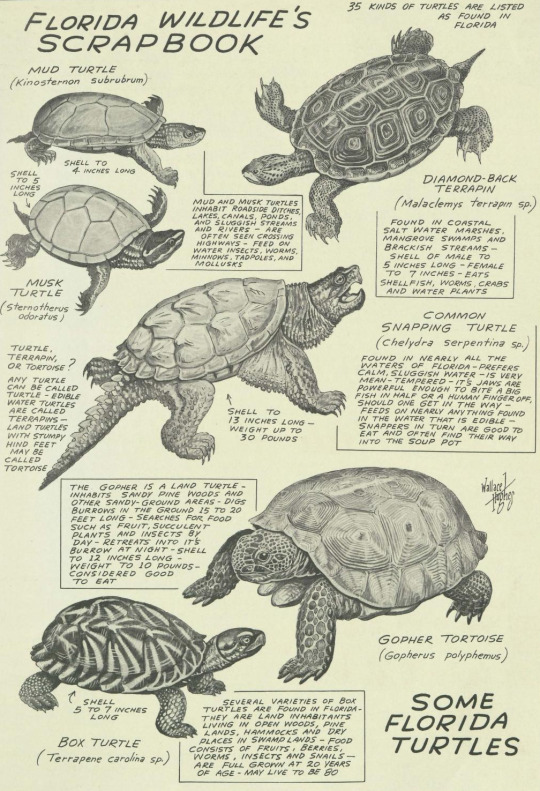
Florida Wildlife; vol. 12, no. 4. September, 1958. Illustration by Wallace Hughes.
Internet Archive
#reptiles#turtles#mud turtles#eastern mud turtle#musk turtles#common musk turtle#terrapins#diamondback terrapin#snapping turtles#common snapping turtle#tortoises#gopher tortoise#box turtles#common box turtle#Wallace Hughes
244 notes
·
View notes
Text

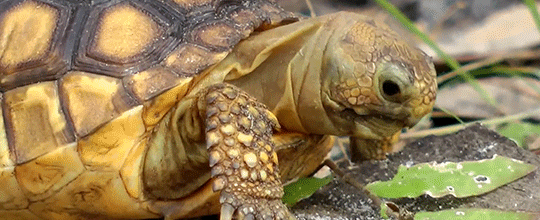
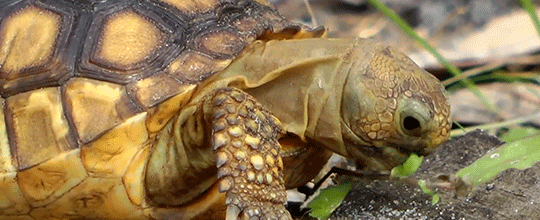
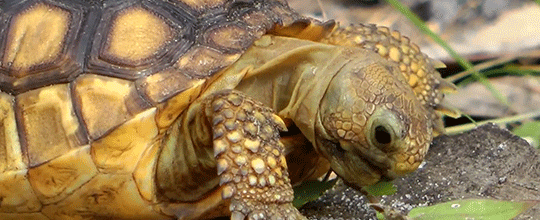
young gopher tortoise feeding on weeds in its natural habitat ©Ryan M. Bolton
175 notes
·
View notes
Text
It's Gopher Tortoise Day!
April 10th was officially adopted by the Gopher Tortoise Council as Gopher Tortoise Day! In Florida, gopher tortoises are found in parts of all 67 counties and are frequently encountered in neighborhoods, along roadways, and in many of Florida’s public parks and forests. The goal of Gopher Tortoise Day is to increase awareness and appreciation for these long lived, gentle reptiles. Gopher tortoises are considered a keystone species because they dig burrows that provide shelter for 360 other species of wildlife, called "commensals." These commensal species include the gopher frog, Florida mouse, eastern indigo snake, and hundreds of invertebrates like beetles and crickets. Without the gopher tortoise, many of these species would not exist.
- gophertortoisedayfl.com

#GopherTortoiseDay#gopher tortoise#pic from FWC email#i love these guys! as a kid i used to go hiking with my dad near swiftmud and there were a bunch of these guys
126 notes
·
View notes
Text

some Florida wildlife (alligator, manatee, gopher tortoise, anhinga, "palmetto bug"), interlocking crochet
450 notes
·
View notes
Text


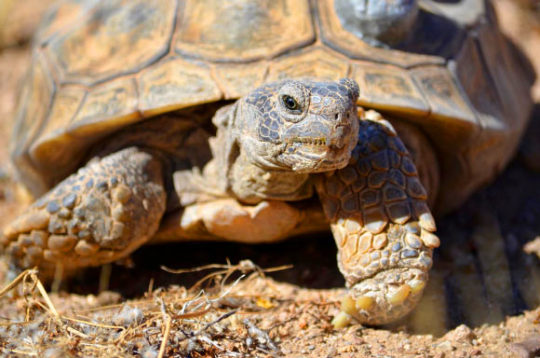
Mosey On with the Mojave Desert Tortoise
Also known as the California desert tortoise, or more simply the desert tortoise, Gopherus agassizii is one of the few tortoise species native to North America. As its name implies, it is found only in the Mojave and Sonoroan deserts, from northern Mexico into the southwestern United States; there it is the state reptile of California and Nevada. Their habitat consists mainly of of desert scrub, where temperatures can reach over 60 °C (140 °F); however, in the southern reaches of its range, the desert tortoise can also be found in tropical deciduous forests.
To beat the heat, G. agassizii digs burrows where they can rest when its too hot or too cold to forage, and where they can aestivate during the hottest months of the summer and hibernate in the winter. These burrows can be quite extensive, reaching 10 m (32 ft) long, and up to 25 tortoises may share the same burrow. Individuals will often dig out several burrows in their territory, which can range anywhere from 3 to 25 hectares (7 to 61 acres). Many of these burrows will also become homes for other animals, including rattlesnakes, gila monsters, squirrels, burrowing owls, and quail.
Like all tortoises, the Mojave desert tortoise is herbivorous. Most of its food is grass, but due to the limited choice in the desert they may also consume wildflowers, shrubs, and cacti-- both fruits and new growth. Due to their hard shells, this species has few predators as adults, but hatchlings are vulnerable to foxes, coyotes, birds of prey, and gila monsters.
Very little rain falls in the desert, and so the desert tortoise is well adapted to do without; the species stores up to 40% of its body weight in water in its bladder, to be absorbed later. Individuals will also dig shallow 'watering holes' in the ground, to be visited after rainfall. G. agassizii also gets much of its water content from its diet, and can go up to a year without drinking.
Desert tortoises typically mate in the spring, from March to May, though mating can continue until autumn. Males seek out and fight each other for access to females, typically by ramming each other or attempting to flip each other over. However, this species is also one of the few known to engage in homosexual activity, particularly between males. Because this is not a species that mates for life, or maintains strict social hierarchies, the purposes of this intercourse is unknown.
Females can store sperm for up to eighteen months, and typically lay their eggs in the following year from May to July in clutches of 3 to 8. These eggs are laid in a deep nest dug into the ground, and take 90 to 135 days to hatch. Young emerge in the fall, and receive no parental care. If they survive, individuals may take between 10 to 16 years to become fully mature, and can live to be 80 years old.
Desert tortoises are well adapted to blend into their environments. The shell is typically a brown or dull yellow, while the body is tan or dusty grey. There is little difference between males and females, save that males are slightly bigger and have a concave plastron (lower shell) to accommodate mounting onto a female. The species is medium sized, ranging between 11 to 23 kg (24.23 to 50.66 lb) in weight and 25 to 36 cm (10 to 14 in) in length.
Conservation status: The IUCN has ranked the Mojave desert tortoise as Critically Endangered. Their primary threats include habitat fragmentation and loss, predation by feral dogs, and road mortality. The population is estimated to have declined by 90% since the 1980s. However, conservation programs are being implemented to preserve critical habitat, and several zoos and conservancies have captive breeding programs for the species.
If you like what I do, consider leaving a tip or buying me a ko-fi!
Photos
Dana Wilson
Bruce D. Taubert
Sandra Leander
#mojave desert tortoise#Testudines#Testudinidae#gopher tortoises#tortoises#turtles#reptiles#deserts#desert reptiles#scrubland#scrubland reptiles#central america#north america#southern north america#animal facts#biology#zoology
232 notes
·
View notes
Text
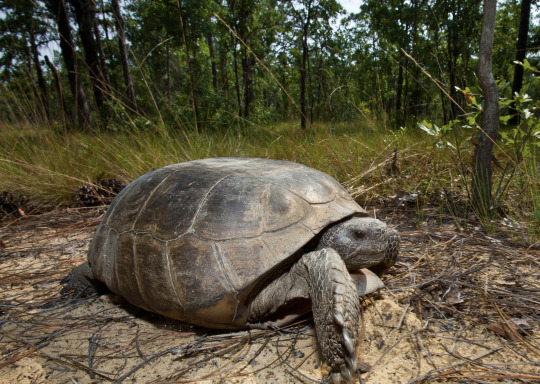
Excerpt from this story from WTSP:
New research is showing that the majority of gopher tortoises could be at risk of extinction in less than 80 years.
According to a study from the Center for Biological Diversity, a new model that details population viability for the tortoises predicts that less than 1% of the species will be around by the year 2100.
This comes after a previous model was discovered to have several errors and overestimated future tortoise populations. It stated that 67% would be around in the same time period.
The flawed model was used so the U.S. Fish and Wildlife Service could deny the species protections from the Endangered Species Act back in 2022, the study explains.
“The previous model was far too flawed to use as a basis for decision making,” said Kevin Shoemaker, Ph.D., a professor of population ecology, in a statement. “I hope the Service does the right thing and re-evaluates their decision. In the meantime, researchers should move quickly to develop a more realistic model to support conservation decisions for this ecologically important species.”
Other errors discovered in the model include a movement of gopher tortoises that produced an "inadvertent positive feedback loop," indicating that the populations were growing faster than biologically possible.
The study also learned the previous model accelerated the rate of sexual maturation of younger gopher tortoises, causing inflated population growth predictions.
“Demographic models are powerful predictive tools for wildlife management decisions, but it’s critical that they be constructed correctly and that the parameters are based on sound scientific data. Unfortunately, the original model that was used to predict the future survival of gopher tortoise populations was significantly flawed and resulted in an erroneous decision by the Service,” said Matthew Aresco, Ph.D., biologist and board member at Nokuse Education, Inc, in a statement.
Researchers explain that the U.S. Fish and Wildlife Service denied protections from the Endangered Species Act for gopher tortoise populations in Florida, Georgia, South Carolina and most of Alabama. Tortoises in Louisiana, Mississippi and western Alabama were allowed protections.
4 notes
·
View notes
Text

Gopher Tortoise (Gopherus polyphemus)
Taken at Turkey Creek Sanctuary in Palm Bay, FL
#gopher tortoise#gopher tortoises#tortoise#tortoises#animal#animals#animal photography#wildlife#wildlife photography#nature#nature photography#photography#florida#florida photograhy#florida photographer#turkey creek sanctuary#wildlife sanctuary#nature trail#nature trails#nikon camera#nikon photography#nikon d3500#Gopherus polyphemus
9 notes
·
View notes
Text

Well this is awkward
2K notes
·
View notes
Text


A gopher tortoise getting down on a gopher apple. I mean he destroyed that thing


#photography#original photographers#photographers on tumblr#nature#florida#gopher tortoise#tortoise#gopher apple#animals eating#cute animals
325 notes
·
View notes
